HomeStrawberry Seeds
Out of Stock


Out of stock
R30.00
Strawberries are fantastic little fruits which are great in fruit salads, desserts, jams and preserves. Many strawberry seeds need to be cold treated to encourage germination. If your selected seeds require this, fear not. It is easy. Simply wrap your seeds, put them in an airtight container, and place them in a freezer. This simulates […]
Minimum of 30 seeds per pack
Every seed undergoes organic cultivation and self-testing on our South African, Botswanan, Zambian, and Tanzanian farms. Our commitment lies in offering a diverse selection of organically grown, open-pollinated, Non-GMO seeds, proudly produced and acclimated locally.
Before planting, please verify the conditions in your area suitable for the specific seed type. Growth rates and germination times hinge on various factors like soil conditions, rainfall/watering patterns, climate, and more. The outcome of growth and harvest may be influenced by these conditions.

Every seed variety undergoes organic cultivation and self-testing on our South African, Botswanan, Zambian, and Tanzanian farms. Our commitment lies in offering a diverse selection of organically grown, open-pollinated, Non-GMO seeds, proudly produced and acclimated locally. Before planting, please verify the conditions in your area suitable for the specific seed type. Growth rates and germination times hinge on various factors like soil conditions, rainfall/watering patterns, climate, and more. The outcome of growth and harvest may be influenced by these conditions.